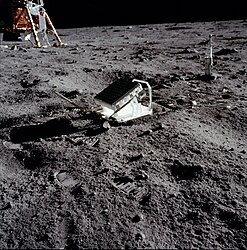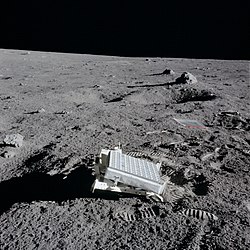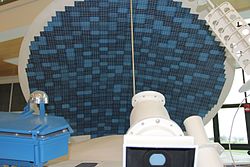Lunar Laser Ranging experiment
Lunar Laser Ranging experiment ou Apollo landing mirror, é um procedimento atualmente em uso que mede a distância entre as superfícies da Terra e da Lua usando a tecnologia LIDAR. Nele, lasers em observatórios na Terra são direcionados para retrorrefletores colocados na superfície da Lua durante o Programa Apollo (11, 14, e 15), e os dois do Programa Lunokhod.[1] Pulsos de luz laser são transmitidos até a Lua e refletidos de volta à Terra. A duração da viagem desses pulsos é mensurada, e a distância lunar é calculada a partir desse valor.[carece de fontes?]
-
 Apollo 11 Lunar Laser Ranging Experiment (LRRR)
Apollo 11 Lunar Laser Ranging Experiment (LRRR) -
 Apollo 14 Lunar Ranging Retro Reflector (LRRR)
Apollo 14 Lunar Ranging Retro Reflector (LRRR) -
 Apollo 15 Lunar Ranging Retro Reflector (LRRR)
Apollo 15 Lunar Ranging Retro Reflector (LRRR)
-
 Modelo do Lunokhod-2 com seu retrorrefletor
Modelo do Lunokhod-2 com seu retrorrefletor -
 Detalhe do retrorrefletor do Lunokhod 2
Detalhe do retrorrefletor do Lunokhod 2 -
 O Lunokhod 1 com seu retrorrefletor aberto
O Lunokhod 1 com seu retrorrefletor aberto
Ver também
- Apache Point Observatory Lunar Laser-ranging Operation
- Pacote de Experimentos da Superfície Lunar da Apollo
- Reflexão lunar
- LIDAR
- Distância lunar
- Programa Lunokhod
- Satellite Laser Ranging
- Evidências independentes das missões lunares
Referências
- ↑ Chapront, J.; Chapront-Touzé, M.; Francou, G. (1999). «Determination of the lunar orbital and rotational parameters and of the ecliptic reference system orientation from LLR measurements and IERS data». Astronomy and Astrophysics. 343: 624–633. Bibcode:1999A&A...343..624C
Ligações externas
- The Lunar Laser Ranging Retroreflector Array
- Apollo 11 - Laser Ranging Retroreflector
- The Apollo 15 Lunar Laser Ranging RetroReflector
- China just bounced a laser off reflectors on the Moon placed by NASA's Apollo 15 mission
- NASA green lights upgrade of Apollo era lunar laser experiment
- Lunar laser ranging: 40 years of high-level science
- Why Is the Apollo Reflector Experiment Still Operating, 50 Years Later?
 | Este artigo sobre astronomia é um esboço. Você pode ajudar a Wikipédia expandindo-o.
|


















